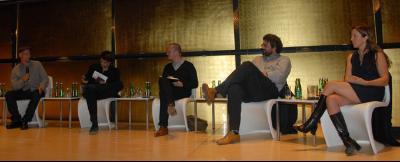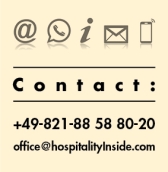Visions on the future of living - design hotel forum in Vienna
Vienna (November 3, 2006). The Californians have meanwhile installed coffee machines in their cars. Hardly surprising when one considers that statistics show that they spend up to 15 percent of their time on the roads. The first tailor made ship containers are also beginning to appear, a mobile house if ever there was one. But the traveller of today doesn't need a house. He can bathe in airport lounges and can work in his hotel room. These are the facts and the visions for living in the future as discussed by international consultants and architects/designers at the "Future Forum" of the design hotels in Vienna recently. The event closed on a note from the Trend Director of London's renowned Future Laboratory. Trend specialist Tom Savigar presented his ideas on luxury, brands and design.
 |
| Design and living in discussion: (from left) Nick Schweiger, Friedrich von Borries, Tom Savigar, Greg Lynn und Jennifer Siegal. |
Following on from what the speakers had to say, the mobile person no longer views his house as his roots. He's continually on the look out for the extraordinary. Because he's no longer in a position to be able to afford his own apartment in most places, he seeks new meeting points - golf courses, spas, green spaces, places of architectural interest. But what does he find in his search for architectural excellence? Tired, sad, boring buildings...
But it's here that a more silent revolution is underway. Buildings are becoming more open, lighter, rounder, more asymmetric. One example of which was presented by Nick Schweiger from Berlin. "Genetic architecture" - housing structures whose "organism" is defined by natural materials. He took inspiration for his restaurant design with round, comfortable seating spaces and separating walls of light from a water droplet.
"Architecture and design are today very closely linked to consumer tastes," the American architect Greg Lynn says, "architecture is further away from art that it's ever been." Fashion designer have long since understood this. Whether Ralph Lauren, Armani or Missoni - all of them design for all branches of industry. The result is that design has gained massive inertia and now moves at speeds which architecture is hardly able to match. This means also: Design is no longer restricted to the four walls.
Design is a taste of luxury - even when it's temporary, for instance in a hotel or airport lounge. Design here is responsible for making the consumer feel good about himself. The more the mobile person sees on his travels, the more he experiences, the more he tends to mix design and wellness elements and the jacuzzi from the hotel suite soon lands in his own bathroom, just as the fireplace in the hotel room is making a return. Friedrich von Borries appealed to designers to place more emphasis on the intelligent and social use of design. All participants in the discussion were unanimous as regards hotels: The lobby will take on increasing significance in the future; it will become a destination. A new "lobby culture" will arise. And with that, design achieves its last more human note. / Maria Puetz-Willems
NO MANTRA FOR FUTURE LIVING
Tom Savigar, Trends Director of the renowned Future Laboratory in London gave owners, investors and operators of design hotels a taste of his views of luxury, brands and design of the future.
• There is no mantra for "future living". The central question is: What unites the poles, how are terms such as comfort to be understood, how should one react to increasing stress levels, what is authenticity?
• Luxury is today a mass market. What is personal, authentic luxury?
• As far as luxury brands are concerned, less is more.
• The luxury of the 21st century is value in contrast to "monetary value".
• The experience counts for more than the product itself
• Sensations, feelings and light determine luxury.
• The ordinary has to be made more interesting, more extraordinary
• Unique is in. The consumer wants to be the first to possess or experience something
• Spaces present only few objects
• Many things can only be viewed in the stores and have to be bought online.
• Materials give the old new life - for instance the gold plated toilet seat.
• Designers need to bring values together
• The consumer is moving away from the copy and wants the real thing
• Luxury brands are becoming more eco-orientated.
• Materials should be environmentally friendly, be produced ethically and regionally.
To print this article you have to be registered and logged in for newsletter, visitor or subscription.





